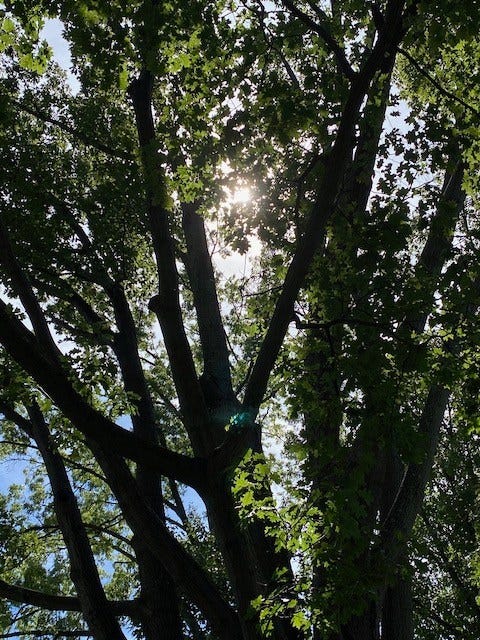The Wonder of Joy
Nature & Happiness
Most mornings, after feeding the dogs and reading my Bible, I lace up my running shoes and head outside. I’ve been an on-again off-again runner most of my life, depending on schedules and illnesses and outside obligations. Sometimes, I’ve gone for months without running for one reason or another.
But so far, I’ve always come back to it. With one painful stride after another, I get back in shape, eventually even enjoying runs again. But whether or not my occasional returns to running prove successful and sustainable or fall flat and fizzle usually depends on nature.
See, we have a family membership at the local YMCA, and they have both an indoor running track and a whole bank of treadmills. When it’s raining or snowing, I’ve often found myself sweating it out there inside. But after a while, seeing only my reflection in the glass in front of the treadmill, or looking at the same concrete walls as I run around the track, fail to inspire me. Until one morning, when I’m a little extra tired, I’ll just not go. And then the next morning, because I have an early meeting, I’ll not go again. And pretty soon I’m no longer running.
This doesn’t happen when I’m able to run outside. I prefer mornings to afternoons and cool temps to warm, but for the past year, and more intentionally since April, I’ve run in every kind of weather imaginable, and I’m still going. Now I’m even training for a 10k run in October. And if there’s any one secret to my success I will always point to nature. When I’m outside, I’m just happier.
Actually, happy might not be the right word. It’s not like nature is always easy to be with. In addition to the fluctuations of temperature and precipitation–or what we more generally call weather–there’s also the matter of bugs, the messiness of decay, the debility of pollution, and the inevitability of upcoming seasons, which at this point in the year shall remain unnamed (hint: it includes snow and freezing temperatures).
Being outside in close proximity to these less desirable aspects of nature don’t lessen my sense of contentment, delight, and happiness, but they do make them more complicated. In fact, I think the better way to describe how I feel when I’m breathing in fresh air beneath nothing but the sky surrounded by plants and trees is simply this: joy.
But how does joy in nature differ from happiness? I like how English naturalist and journalist Michael McCarthy, author of The Moth Snowstorm: Nature and Joy, describes it in a recent episode of the On Being podcast. The host, Krista Tippett, asks McCarthy to talk about what joy really is, prompting him by saying, “It’s something that’s distinct from mere fun or happiness or pleasure, although it may contain all of those things.” And he responds:
“Well, in fact, you’re right. If we look, what is joy, I say it’s an intense happiness; yes, it is. But it’s somehow one that is set apart. It’s not the same as fun, or even delight. We don’t use it to define our pleasure in eating a particularly well-made pizza. But we might well think it was appropriate to describe the feelings of a parent finding a missing child, finding them safe and well, or the feelings of a lover whose love for another person has long been unrequited but who, at last, finds it being returned. All I say is that joy looks outward to another person, to another purpose; and I say that joy has a component, if not of morality, then at least of seriousness. It signifies a happiness, which is a serious business.”
So how does nature inspire this “serious business of happiness” or joy in us? McCarthy names a couple ways. Sometimes, it happens suddenly, he says, “and you don’t quite realize what you’re feeling, when you’re suddenly taken over with this very strong emotion in certain circumstances. It can be in a sunset. It can be in the presence of a landscape.” Other times, it happens more slowly, like when “the reawakening of the world every spring … stirs very, very profound emotions in us.”
Then there’s the way God seems to have woven joy into the very fabric of nature. I love the way Psalm 65 depicts the movement and energy of nature and taps into God’s favor and care for the earth as evidence of His favor and care for us.
David begins by telling us that this is a psalm of praise. Because God answers prayers, forgives sins, welcomes his people, and gives good gifts, David blesses the Lord. But it’s not just in his own life that he sees God at work. Beginning in verse 5, David takes us on a tour of God’s work in the world: from the farthest seas to the highest mountains, from crashing waves to the fading sun, from the bounty of crops to the abundance of grasslands, to hills covered by flowers and flocks, God’s world is singing for joy because of his glory.
Of course it’s hard not to see the intricate connection between praise and joy woven in these verses. And I might even add gratitude. How can we not be thankful?
Yet just as McCarthy says: our response to nature elicits something more in us than a good slice of pizza does. We hold our joy in the same hands that we carry burdens. We run through nature and find our peace because the world is so very fractious. And for those few moments of breathing deeply and listening to the cicada chorus serenade us, we are okay.





